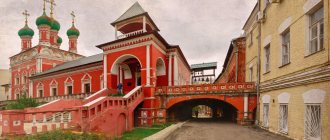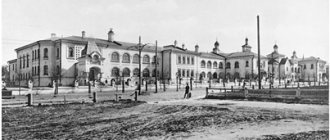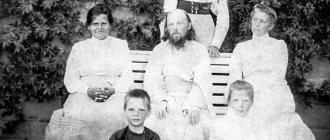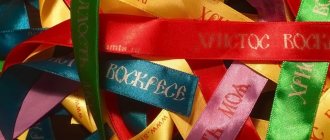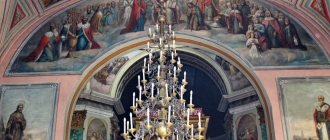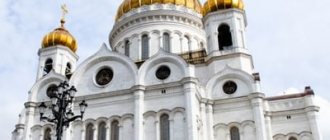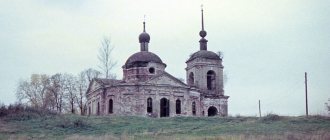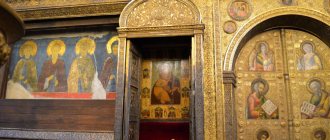Moscow churches are magnificent. Each of them has its own unique architecture and history. The Rogozhskaya side of Moscow is famous for both the Church of St. Sergius of Radonezh and the Church of Alexy of Moscow attached to it.
The Church of St. Alexy of Moscow on the Rogozhskaya side is a Russian shrine built in the mid-18th century; its architectural style was Elizabethan Baroque. The Old Moscow Church is recognizable from afar with its red and white, gingerbread color and golden domes.
Briefly about the saint
Iconography: Alexy, Saint, Metropolitan of Moscow Dates: XV century. Second half of the 15th century. Origin: Comes from the Intercession Monastery in Suzdal. Material: Wood, gesso, tempera, canvas. Dimensions of the icon: height 28 cm, width 21 cm Half-length image of Metropolitan Alexei with a blessing right hand in front of his chest and the Gospel in his left hand. The saint is dressed in a white hood with golden cassocks and a sakkos-polystauria. A special feature of the icon is the inscription “The miracle worker of Alexia”, where the metropolitan is not called a saint, and the word “miracle worker”, contrary to custom, precedes the name. Inv. No. B-6300/38 © Vladimir-Suzdal Historical, Artistic and Architectural Museum-Reserve Literature: Icons of Vladimir and Suzdal. M., 2006. No. 4. pp. 96-99. (Description by A.S. Preobrazhensky
The son of a boyar, Eleutherius early felt the calling to monastic life. The young man withdrew from the world, the place of his “promise”, as they then said about the monastery of tonsure into monasticism, became the Epiphany monastery in Moscow. Here Alexy grew in spirit for several decades. And then the Lord called him to serve the world.
Metropolitan Theognost, who loved the humble monk, forced him to first accept the rank of bishop, then to become the primate of the Russian Church. Faithful to monastic obedience, Alexy fulfilled everything he was commanded. One can only guess what it cost the monk to delve into the state affairs of the Moscow principality when the prince was a minor. Dimitri Ivanovich (the future Donskoy), travel to Constantinople, persuade the Mongol khans to postpone raids on Rus', and not impose tribute on the Church.
And how much horror the humble Alexy must have experienced when they demanded of him a literal miracle - the cure of the blind wife of the Mongol ruler, Taidula! But the saint’s faith was not disgraced - God’s help was always with him, whether at prayer in a quiet cell, or among worldly troubles.
12
February
1378
Having lived his life not as he dreamed, but as the Lord commanded, Metropolitan Alexy reposed in order now, in the Kingdom of Heaven, to continue praying for his flock.
Life: Saint Alexy, Moscow Wonderworker
In Rogozhskaya Sloboda
Temple in honor of St. Alexy Moskovsky in Rogozhskaya Sloboda, Moscow.
This historical district of the capital has been known since the 17th century, when there was already a wooden church here. It is believed that it was erected on the spot where St. Alexy lived in a small tent, overseeing the construction of the nearby Spaso-Andronikov Monastery. After all, it was founded according to his vow made during a terrible sea storm in 1361.
The church was originally dedicated to the Feodorovskaya icon of the Mother of God, and St. Only one of its boundaries is dedicated to Alexy. However, residents also called the temple Alekseevsky. This double name - Fedorovsky and Alekseevsky - remains to this day.
The current building was built in the mid-18th century. It belongs to the architectural monuments of the Baroque style. This saved the church from destruction during the persecutions of the Soviet years, although the temple was robbed (1922). Its restoration began in the early 1990s.
Now the church on the corner of Nikoloyamskaya (60) and Stanislavsky (29, building 1) streets is open daily, but some restrictions on visits remain due to the pandemic.
Services are held in the morning from 8 am and in the evening from 6 pm.
Address: st. Stanislavsky, 29, building 1, Moscow.
Moscow Church of St. Alexy, Metropolitan of Moscow
| Church of St. Alexy, Metropolitan of Moscow, in Rogozhskaya Sloboda. 19th century photo |
The church of St. that has survived to this day. Alexy, Metropolitan of Moscow, is located on the corner of Nikoloyamskaya and Malaya Alekseevskaya streets, near Rogozhskaya Sloboda and directly opposite the local church of St. Sergius, about whom we wrote in the October publication. Now dilapidated, this is one of the most beautiful and legendary Moscow churches dedicated to St. Alexis. According to legend, it was built on the spot where his tent once stood, from where the Moscow high priest oversaw the construction of the Spaso-Andronikov Monastery, founded on his vow in 1361 for his miraculous salvation during a storm. There is another version that the Monk Sergius himself stayed in this tent, also overseeing the construction of the monastery, where his beloved disciple St. Andronik. However, the church was founded in a historical area closely associated with the life and work of St. Metropolitan Alexy and in memory of him.
| Saint Alexy, Metropolitan of Moscow and All Russia, Wonderworker |
Saint Alexy was born in Moscow in 1292 in the family of the boyar Fyodor Byakont and in 1320 he took monastic vows at the Moscow Epiphany Monastery in Kitai-Gorod. He put a lot of effort and effort into the victory of Rus' over the Tatar-Mongols, to unite the Russian principalities around Moscow and united national resistance to foreign conquerors, and at the same time to establish peaceful diplomatic relations with the Horde.
The authority of the saint was great there too. As you know, in 1357, when the Tatar Khan’s wife, Taidula, suddenly became blind, he summoned Moscow Metropolitan Alexy to the Horde and asked him to heal his wife. For the miraculous healing accomplished through prayer, Taidula, who had regained her sight, gave the saint the Khan’s land in the Kremlin, on which he founded another Moscow monastery, Chudov. There the saint was buried after his death on February 12 (25), 1378. After the demolition of the Chudov Monastery by the Bolsheviks, his holy relics were transferred to the Elokhovsky Epiphany Cathedral, where they now rest.
However, in honor of St. Alexy in the Moscow church on Nikoloyamskaya, according to tradition, a chapel was consecrated, and the main altar was dedicated to the miraculous Theodore Icon of the Mother of God, the patroness of the House of Romanov. This is the only surviving Moscow church, consecrated in the name of an ancient Orthodox Russian shrine.
This icon, painted, according to legend, by the Evangelist Luke himself, was originally located in the Gorodetsky Feodorovsky Monastery near Nizhny Novgorod, where it stood in the cathedral church of St. Theodore Stratelates. During Batu's invasion, the residents fled from the devastated town and did not have time to take the revered image with them.
However, the icon itself appeared again in 1239 to the Kostroma prince, who, while hunting in the forest, suddenly saw it on a tree. And it turned out that not long before that, the residents of Kostroma saw a stranger in rich military clothing walking through the city and carrying this icon in his arms - this man was very similar to St. Theodore Stratilates, as he is depicted on icons.
The miraculously revealed icon was reverently placed in the Kostroma church - again in the name of St. Theodora Stratelates, which is why it began to be called Feodorovskaya. One of her holidays falls on August 29 of the new style in memory of her miraculous appearance and acquisition.
Soon other miracles were revealed from the Theodore Icon. When the Tatars rushed to Kostroma, a radiance appeared from the image, and this fire burned the enemy hordes, who turned into panicked flight. And then the church burned down, and people saw the miraculous icon rising above the flames - falling to the ground, they tearfully prayed to the Mother of God not to leave them without Protection. Then the icon sank to the ground and stood in the middle of the square, where a new stone temple was built for it.
And the Feodorovskaya icon was also a prayer image of the father of Alexander Nevsky, Prince Yaroslav, who received the name Theodore at baptism.
And in March 1613, nun Martha blessed her son, Mikhail Romanov, with her for the kingdom. For a long time he did not agree to ascend the Russian throne, and then the archbishop took this icon in his hands and, together with the mother of the future king, said to him: “If you do not bend to mercy for our sake, then obey for the sake of the miraculous image of the Queen of all.” And when Michael agreed, his mother fell on her knees in front of the icon and prayed before it with tears: “Behold, Most Pure Mother of God, I commend my child to You. According to Your will, arrange something that will benefit him and all Orthodox Christianity.”
Hence, another holiday to the Feodorovskaya icon in memory of the election of the king was established on March 27 according to the new style. And the Romanov family decorated the revered image with rich gifts and jewelry.
So, inconspicuously, although in the central part of Moscow, lurked a modest church associated with such significant events and persons of Russian history.
Initially wooden, it was built only at the beginning of the 17th century as an ordinary parish church for the local population of the sovereign settlement, named after the Alekseevskaya Church. Thus, by building a suburban church right here, opposite the Spaso-Andronikov Monastery and on the site of the legendary tent of its founder, they honored the memory of the Moscow saint. Moreover, the inhabitants of the settlement were black drafters, that is, obliged to perform state duties. Perhaps that is why the main altar of the temple was dedicated to the patroness of the ruling royal dynasty of Russia.
In addition to the settlement, the church gave the Old Moscow name to two adjacent streets - Bolshaya and Malaya Alekseevskaya. In Soviet times, they were renamed Communist Streets, because it was here, on Bolshaya Street, that in October 1917 the district party committee, the Council of Workers' Deputies and the Military Revolutionary Committee of the Rogozhsko-Simonovsky district operated.
And Nikoloyamskaya Street, on which the Alekseevskaya Church stands, was named after another local church, destroyed after the revolution - St. Nicholas the Wonderworker, “what is in the Yams,” that is, in the Yamskaya settlement, established here by Boris Godunov. It was renamed Ulyanovskaya during Lenin’s lifetime.
In ancient times, until the 15th century, all these lands belonged to the Spaso-Andronikov Monastery. Then Grand Duke Ivan III took them for himself and laid out his favorite gardens here. And somewhere here at the beginning of the 17th century, Shuisky’s troops fought with the Poles, and from 1671 Moscow archers settled in this area - and all this was long before the Old Believer center was established here. Even when the Old Believers settled here near their Rogozhsky cemetery, Orthodoxy closely coexisted with them - witness the Alekseevsky, Nikolsky, Sergievsky, and Martinovsky churches, and the Church of St. Basil the Confessor, which will be discussed in the March publication.
To replace the first wooden Alekseevskaya Church of the early 17th century, a stone church was built almost a century later, in the earlier time of Peter the Great.
| Church of St. Alexy, Metropolitan of Moscow, in Rogozhskaya Sloboda. Photo: hram.codis.ru |
Church of St.
Alexy, Metropolitan of Moscow, in Rogozhskaya Sloboda. Current state Photo from the site hram.codis.ru And in the middle of the 18th century, under Empress Elizabeth, the brilliant architect Dmitry Ukhtomsky built here the now existing building of the Alekseevsky Church, which has survived to this day in ruins. Who would have known that before the revolution this church was considered the best and classic example of Moscow Elizabethan Baroque architecture. To imagine what it looked like (and what it will be like after modern renovation), you only have to remember that the same master built the famous Baroque bell tower in the Trinity-Sergius Lavra and the Red Gate in Moscow, alas, now known to us only from photographs. And almost opposite the Alekseevskaya Church, on the same Nikoloyamskaya street, Prince Ukhtomsky rebuilt the house of the merchant Fyodor Ptitsyn from ancient chambers - one of the most beautiful buildings on this ancient Moscow street.
And the interior of the best example of Moscow Elizabethan baroque left memories of itself. Apollinary Vasnetsov admired the rich, gilded baroque iconostasis on the altar side, which contained valuable icons of Novgorod writing from the 15th - 16th centuries. Moreover, he considered even the late wall painting of the 18th century to be a work of art
Another attraction of the Alekseevskaya Church was the ancient cross above its central head - it was moved there from the first, dismantled temple. And in 1747, when Ukhtomsky began construction of this church, an almshouse was set up for 10 parishioners, where, in addition to the apartment, the old women received another 7-8 rubles per month. Of course, funds for the temple and for charity were collected by its parishioners - and the Orthodox parish of this church was wonderful. It is enough just to name the names of the Alekseevs and Chelyshevs.
Bolshaya Alekseevskaya was the main street of the settlement. The late professor of Moscow State University, A.Ch. Kozarzhevsky, famous among the Orthodox Moscow public, in his lectures on the history of Moscow called it the most beautiful street in the capital. And the pre-revolutionary writer of everyday life of these places believed that what made it a beautiful street were the magnificent rich houses, built, by the way, exactly along the red line in the 18th - 19th centuries, when Moscow merchants began to settle in this area near Taganka.
The mentioned Chelyshevs, the builders of the popular hotel and baths “Chelyshi” in Teatralny Proezd, where Savva Mamontov later built his “Metropol”, did not live here for long. They owned house No. 27 on B. Alekseevskaya Street, and in 1835 it was bought from them by the widow of Semyon Alekseev, the founder of the famous industrial dynasty that gave birth to K.S. Stanislavsky and his relative, the famous Moscow mayor N.A. Alekseev.
It is with this surname that the main milestones in the history of the ancient Alekseevskaya Sloboda are associated. The most surprising thing is that the Alekseevs’ settlement here is in no way connected either with the local church - it appeared long before - or with the settlement itself. Scientists call this a coincidence, but studying history, it is difficult to agree with this - such coincidences do not happen. The Alekseevs were not Old Believers, like their neighbors the Morozovs, and did not gravitate towards this area, close to the Rogozhskaya Sloboda. On the contrary, they revered the neighboring Orthodox church, consecrated in the name of the heavenly patron of their family, and when it was renovated in 1898, the Alekseevs took the most ardent part in this.
The founder of this Alekseev dynasty, Stanislavsky’s great-grandfather, began the initiative of charity and donated a large sum to the needs of the people’s militia in 1812, and his name was even engraved on the marble slab of benefactors of the Cathedral of Christ the Savior.
He settled here in a quiet merchant area on Taganka after the fire of World War II. His gold-weaving factory of “drawn and cloaked gold and silver,” which produced the finest brocade thread, from which they made brocade, vestments of clergy, and court uniforms with expensive gold embroidery, burned down in the fire. The demand for these products, of course, was so great that over time, the Alekseev gold-plating factory became the largest Russian enterprise in this field, and the Alekseev surname became a symbol of strength, reliability and success. And then it was at their factory that the method of galvanic coating of wire with noble metals was first used, and since 1909, wires and cables began to be produced here. Nowadays it is Moscow Cable on M. Alekseevskaya Street, operating in the same old building.
And at first the Alekseevs lived near their factory - in a luxurious house on Bolshaya Alekseevskaya, 29. Previously, this mansion belonged to the Moscow mayor V.Ya Zhigarev, with whose funds the amazing church of St. Martin the Confessor designed by the architect Rodion Kazakov, a favorite student of Vasily Bazhenov and Matvey Kazakov. There is a version that the same architect, invited to build the temple, at the same time built the customer’s house itself, which later passed to the Alekseevs.
On January 17, 1863, Konstantin Sergeevich Alekseev was born in this house. And since the genius came from a family of factory owners and was a factory owner himself, for ethical reasons he subsequently took his stage name - Stanislavsky.
Very soon his family left their family home on B. Alekseevskaya, which they had owned for half a century, and moved to Sadovo-Chernogryazskaya Street. Stanislavsky’s father, also a philanthropist, decided to donate his former house to the city to establish a care home for merchant widows and orphans. The Moscow Merchants' Council ordered the reconstruction of the building to A.S. Kaminsky himself, P.M. Tretyakov's son-in-law, and V.O. Sherwood, and the newly built establishment was named Nikolsky in honor of the birth of the heir to the throne, the future passion-bearer emperor Nicholas II.
But only recently, for the anniversary of the capital, a memorial plaque appeared on the wall of this house with the inscription that K.S. Stanislavsky was born in it.
And little Kostya went to study at the gymnasium on Pokrovka, where he ended up in the same class with Savva Morozov, the future patron of his theater - that’s where they met. But first he returned to the family factory and was even elected chairman of its board. “I’ll go to the factory to spin the golden thread,” the future Russian actor joked then. This side of Alekseev’s talent remained in the shadows for a long time, and meanwhile, an orientalist (he graduated from the Lazarev Institute of Oriental Languages) and an engineer, before the founding of the Moscow Art Theater, he was intensely involved in the latest industrial technologies, went to learn from experience abroad, purchased the necessary machines and found out “how to gild without gold."
It didn’t take long for a good initiative to take place. Already in 1894, a reading room for workers appeared at the factory, and on Sundays readings began to be held with the display of “foggy pictures”. And of course, the theater. Stanislavsky got him a job at the factory in 1898, after the famous meeting with Nemirovich-Danchenko, recruiting an amateur troupe of workers, and began teaching them acting skills: according to an eyewitness, Stanislavsky once took a log and in front of everyone began to talk to him like with a person. The repertoire was classical - they staged mainly Ostrovsky's plays, and there was one strict condition - not to include obscene things in the production.
And this theater, in order to avoid clashes with the police, operated under the guise of the Rogozh Temperance Society. Perfumed programs were distributed to visitors with free invitation cards. Commercial considerations were not taken into account - the workers called Stanislavsky unmercenary. He did charity wherever he could: he played in numerous performances for the benefit of poor children, orphans, needy students, and impoverished artists. Like Savva Morozov, he cared about improving the working conditions and housing of his workers. A medical center was opened at the factory, where the entire Rogozhskaya outpost turned for help. All this, according to Stanislavsky, “does not stain the soul.”
And when the First World War began, many warmed their hands to misfortune, receiving incredible profits from the increased demand for necessary products. Stanislavsky, on the contrary, refused part of the profit in favor of the needs of the factory and workers. Unfortunately, this side of the great actor’s life remained neglected for a long time.
In 1909, the factory switched to producing scarce cable and wire, and then it was decided to close the workers' theater. Here too, Stanislavsky bargained for free and cheap places for workers and students at the expense of a factory in the luxurious Moscow Art Theater building in Kamergersky.
And on Malaya Alekseevskaya in 1910-1912. A modern factory building was built adjacent to the Alekseevskaya Church.
Let us mention that the Alekseev dynasty produced another famous and worthy person - the Moscow mayor and philanthropist N.A. Alekseev. It was he who founded the world-famous psychiatric hospital in Moscow at Kanatchikova Dacha near Shabolovka, which now bears his name. (In Soviet times, she was given the name P.B. Kashchenko).
And in his native land, Alekseev founded a city school and in 1883, at his own expense and on his own land, built a building for it at Nikoloyamskaya, 42. The famous architect D.V. Chichagov was invited, who built the City Duma building in Moscow on Voskresenskaya Square (formerly a museum Lenin). And in Soviet times, music school No. 30 operated here, one of the best in Moscow, now famous for the fact that Philip Kirkorov graduated from it.
And the former house of the Chelyshev merchants on Bolshaya Alekseevskaya was sold by the Alekseevs to the famous Varvara Morozova, the mother of the brothers-collectors. She set up a children's secondary school with craft classes here, and then sold it to the Moscow merchant society. And it was rebuilt by the architect S.U. Solovyov for exemplary charitable apartments of the Mazurin philanthropists - with tiles, running water, earthenware washbasins and even oil furnaces in the kitchen stoves. So this entire quiet area between Taganka and Rogozhka was an island of Moscow charity.
Alekseevskaya Church, renovated in 1898, was robbed in the spring of 1922 and closed eight years later. In 1931 they began to break it, but, fortunately, they did not break it, although they demolished the bell tower to the second tier, the drum with the dome and the cross - thus ancient. In a dilapidated building with pipes and ugly hanging stairs, it was difficult to guess the church - it housed a factory, then a repair and construction department.
And during the years of perestroika, they started talking again about the best Moscow monument of Elizabethan Baroque. And plans emerged to create a protected island here, together with the neighboring ancient estates on Nikoloyamskaya. Then there were rumors that the cultural center of the French Embassy would be located here, but in the end a bank was built on the vacant area, and the Alekseevskaya Church was returned to the believers, and the titanic work of its restoration began.
Despite the extremely slow pace, it has now been reconstructed so much that its silhouette can be seen. It is especially beautiful in winter, when its golden domes sparkle festively against the background of white snow and the bright colors of the gingerbread, red and white Old Moscow church play in the sun.
And one more local attraction, perhaps familiar only to old-timers. Near the church on the corner of Andronikovskaya Square there is an old three-story pre-revolutionary house with a shabby grocery store on the ground floor, no different from thousands of similar stores. And just a few years ago, the sweet aroma of hot, freshly baked tea buns wafted from here, for which the whole neighborhood came. After all, it was one of the few Filippov bakeries that survived and operated in Moscow. Its ceilings were decorated in the old-fashioned way with small stucco images of white flowers with green leaves - nothing was spared. Only the house itself still carries the warmth and comfort of old, Orthodox Moscow.
In Serednikovo
This has been known since the 17th century. The church is located in the Moscow region. It was built in 1693 by the Cherkasy boyars. Serednikovo is a historical place associated with famous people of Russia:
- the future poet M.Yu. Lermontov lived here until he was 4 years old (the estate belonged to his grandmother);
- it is known that the wedding of P.A. Stolypin took place in the temple;
- When, during the persecution, the temple remained one of the few not closed, the blessed one came here more than once. Matrona of Moscow.
Interesting fact
Divine services here did not stop throughout the Soviet years, even during the Great Patriotic War, when the capital’s defense line was literally 100 meters from the church fence.
The modern website of the temple reports that services are performed daily, and registration is also kept for the sacrament of Baptism. During the pandemic, certain restrictions on the number of parishioners apply. Services begin at 10:00 in the morning, at 18:00 in the evening, and on Saturdays and Sundays at 10:00 and 16:00.
The address of the church is the village. Srednikovo, 1.
Architectural style
The architect D. Ukhtomsky, according to whose design the Church of Metropolitan Alexy of Moscow was built, took the Elizabethan Baroque as a basis. The quadrangle is complemented on the eastern side by an apse, which has a semicircular shape; on the western side there is a three-tier bell tower with a two-limit refectory.
Pilasters and wide cornices add elegance to the walls. Large windows, made in the shape of arches, are decorated with figured platbands; the uniqueness of the windows on the second floor are the broken pediments.
Inside the Church of St. Alexis of Moscow
In Butovo
This is a temple under construction in the area of the capital Severnoye Butovo, at the intersection of Kulikovskaya and Starobitsevskaya streets . The temple’s website reports that “the ownership number has not yet been assigned.”
The parish has existed since 2014.
Now services are held in a temporary wooden church dedicated to the soldiers Alexander Peresvet and Andrei Oslyaba, monks who took part in the Battle of Kulikovo. The consecration took place on March 14, 2015.
The full daily cycle of worship is performed only on Saturdays and Sundays. Services begin at 9 a.m. and 5 p.m.
Despite the fact that the parish was formed recently, many note the sincerity, warmth, and comfort of this place. Here is a review about the temple left by one of the Internet users:
“A cozy church, a family atmosphere, a kind and understanding priest, rector Fr. Vitaly. Come to the services, let's pray together. All the best and salvation!”
Shrines and patronal feasts
Theodore's image of the Mother of God, according to legend, was written by the hand of the Evangelist Luke.
Previously, the icon was kept in Nizhny Novgorod, showing miracles to the residents of the city more than once. After the invasion of Batu and the flight of the Novgorodians, the shrine left in the church itself appeared in Kostroma in 1239; some Kostroma residents allegedly saw Saint Theodore Stratilates himself bring it to the city.
In honor of the appearance in Kostroma of the shrine of the Alekseevskaya Church, the Orthodox Church celebrates the holiday on August 29. With this icon, Mikhail Romanov, who for a long time did not give consent to reign, but changed his mind in front of the holy image, was blessed to the throne. This is how the second holiday appeared, March 27, the veneration of the holy face of the Mother of God of Feodorovskaya.
The second shrine of the Alekseevskaya Church is the holy image of Simeon the Myrrh-Streaming, whose circle is always crowded. Parishioners come to worship the saint in the hope of miracles, which he performs at the prayerful request of believers.
Important! This is the only Moscow church in which the main chapel is consecrated in honor of the Icon of the Mother of God of Feodorov.
In addition to the veneration of the holy image of the Theodore Mother of God, the following holidays are celebrated in the church of St. Alexis of Moscow:
- February 25 - veneration of Metropolitan St. Alexis;
- May 22 - commemoration of the transfer of the relics of Nicholas the Ugodnik;
- June 2 - commemoration of the discovery of the relics of St. Alexis;
- August 11 - celebration of the Nativity of St. Nicholas the Wonderworker;
- December 19 - St. Nicholas of Myra.
Divine Liturgy in the Church of St. Alexis
In Tula
The young church, whose parish has existed since 1999, is located on the territory of a military unit at 99A Lenin Ave. The decision to build the Church of St. Alexy, as a memory of the fallen soldiers, was accepted by the Officers' Assembly of the Artillery Engineering Institute of Tula.
The iconostasis of the temple was created by Moscow artists - students of Ilya Glazunov, and the royal doors - by carvers from the Novo-Simonov Monastery of the capital.
The first Divine Liturgy took place here on December 29, 2002. Now there are 5 clergy serving here, services are held every day from 8 a.m. and 6 p.m.
At the parish there are:
- catechist courses;
- Sunday School;
- library;
- Greek language club.
Address: Tula, Lenin Ave. 99A

